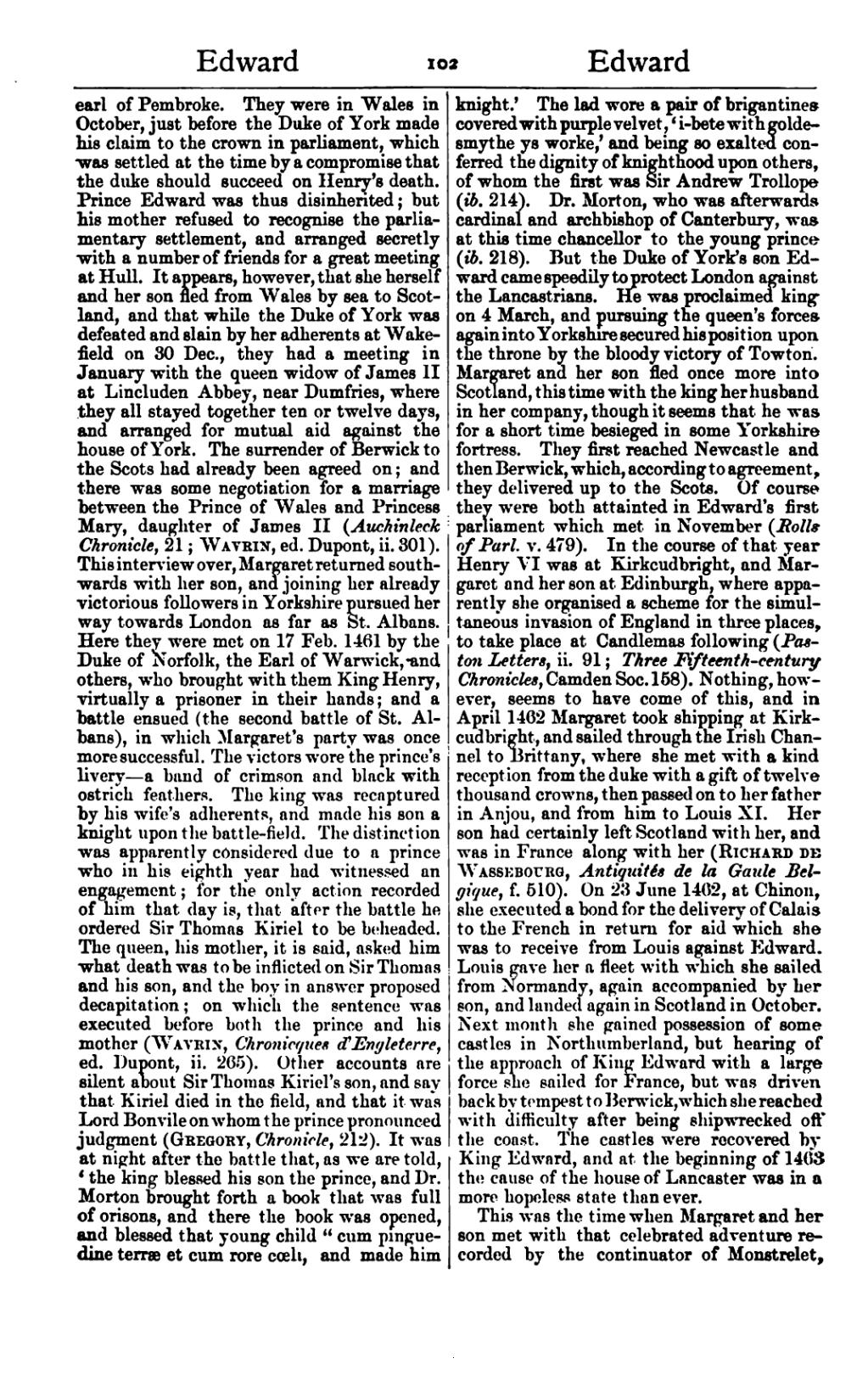earl of Pembroke. They were in Wales in October, just before the Duke of York made his claim to the crown in parliament, which was settled at the time by a compromise that the duke should succeed on Henry's death. Prince Edward was thus disinherited; but his mother refused to recognise the parliamentary settlement, and arranged secretly with a number of friends for a great meeting at Hull. It appears, however, that she herself and her son fled from Wales by sea to Scotland, and that while the Duke of York was defeated and slain by her adherents at Wakefield on 30 Dec, they had a meeting in January with the queen widow of James II at Lincluden Abbey, near Dumfries, where they all stayed together ten or twelve days, and arranged for mutual aid against the house of York. The surrender of Berwick to the Scots had already been agreed on; and there was some negotiation for a marriage between the Prince of Wales and Princess Mary, daughter of James II (Auchinleck Chronicle, 21; Wavrin, ed. Dupont, ii. 301). This interview over, Margaret returned southwards with her son, and joining her already victorious followers in Yorkshire pursued her way towards London as far as St. Albans. Here they were met on 17 Feb. 1461 by the Duke of Norfolk, the Earl of Warwick, and others, who brought with them King Henry, virtually a prisoner in their hands; and a battle ensued (the second battle of St. Albans), in which Margaret's party was once more successful. The victors wore the prince's livery — a band of crimson and black with ostrich feathers. The king was recaptured by his wife's adherents, and made his son a knight upon the battle-field. The distinction was apparently considered due to a prince who in his eighth year had witnessed an engagement; for the only action recorded of him that day is, that after the battle he ordered Sir Thomas Kiriel to be beheaded. The queen, his mother, it is said, asked him what death was to be inflicted on Sir Thomas and his son, and the boy in answer proposed decapitation; on which the sentence was executed before both the prince and his mother (Wavrin, Chronicques d'Engleterre, ed. Dupont, ii. 265). Other accounts are silent aoout Sir Thomas Kiriel's son, and say that Kiriel died in the field, and that it was Lord Bonvile on whom the prince pronounced judgment (Gregory, Chronicle, 212). It was at night after the battle that, as we are told, 'the king blessed his son the prince, and Dr. Morton brought forth a book that was full of orisons, and there the book was opened, and blessed that young child "cum pinguedine terræ et cum rore coeli, and made him knight.' The lad wore a pair of brigantines covered with purple velvet, 'i-bete with goldesmythe ye worke,' and being so exalted conferred the dignity of knighthood upon others, of whom the first was Sir Andrew Trollope (ib, 214). Dr. Morton, who was afterwards cardinal and archbishop of Canterbury, was at this time chancellor to the young prince(ib, 218). But the Duke of York's son Edward came speedily to protect London against the Lancastrians, He was proclaimed king on 4 March, and pursuing the queen's forces again into Yorkshire secured his position upon the throne by the bloody victory of Towton. Margaret and her son fled once more into Scotland, this time with the king her husband in her company, though it seems that he was for a short time besieged in some Yorkshire fortress. They first reached Newcastle and then Berwick, which, according to agreement, they delivered up to the Scots. Of course they were both attainted in Edward's first parliament which met in November (Rolls of Parl. v. 479). In the course of that year Henry VI was at Kirkcudbright, and Margaret and her son at Edinburgh, where apparently she organised a scheme for the simultaneous invasion of England in three places, to take place at Candlemas following (Paston Letters, ii. 91; Three Fifteenth-century Chronicles, Camden Soc.158). Nothing, however, seems to have come of this, and in April 1462 Margaret took shipping at Kirkcudbright, and sailed through the Irish Channel to Brittany, where she met with a kind reception from the duke with a gift of twelve thousand crowns, then passed on to her father in Anjou, and from him to Louis XI. Her son had certainly left Scotland with her, and was in France along with her (Richard de Wassebourg, Antiquités de la Gaule Belgique, f. 510). On 23 June 1462, at Chinou, she executed a bond for the delivery of Calais to the French in return for aid which she was to receive from Louis against Edward. Louis gave her a fleet with which she sailed from Normandy, again accompanied by her son, and landed again in Scotland in October. Next month she gained possession of some castles in Northumberland, but hearing of the approach of King Edward with a large force she sailed for France, but was driven back by tempest to Berwick, which she reached with difficulty after being shipwrecked off the coast. The castles were recovered by King Edward, and at the beginning of 1463 the cause of the house of Lancaster was in a more hopeless state than ever.
This was the time when Margaret and her son met with that celebrated adventure recorded by the continuator of Monstrelet,
